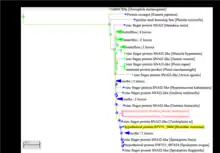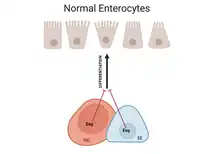| Escargot | |||||||
|---|---|---|---|---|---|---|---|
| Identifiers | |||||||
| Organism | |||||||
| Symbol | Dmel/esg | ||||||
| UniProt | P25932 | ||||||
| |||||||
Escargot (esg) is a transcription factor expressed in Drosophila melanogaster. It is responsible for the maintenance of intestinal stem cells and is used as a marker for those types of cells in Drosophila.[1][2][3] Apart from its expression in the gut, esg is also expressed in expressed in germline stem cells and cyst stem cells of the testis[4][5] and, during development, in neural stem cells and imaginal disks.[6][7][8]
Discovery
In the year 1992, Mary Whiteley and coworkers identified a gene which is very similar to Drosophila Snail gene and named it escargot. They found that it encodes for zinc finger like snail related genes.[1]
Pathways associated with escargot
Delta-Notch signaling
Esg acts through the Notch signaling pathway to repress differentiation-related genes in the Drosophila gut. Intestinal stem cells produce the ligand for the Notch receptor i.e., Delta which activates a transcriptional program that leads to the differentiation of enteroblasts to enterocytes and Escargot represses this.[2] Esg and Scratch act redundantly to determine neural commitment in sensory cells by antagonizing Notch activity which is required for neuronal fate determination by regulating the number of neural precursor cells and also by directing the cells fates to their neural type lineages. Esg along with scratch were reported to be involved in assigning neural commitment and induce neural cell type fates in Drosophila mechanosensory organ lineage cells [9]
Insulin receptor pathway
Esg is required for the maintenance of somatic cyst stem cells in their stem state. The testis in Drosophila has two types of stem cells i.e., the germline stem cells and the somatic cyst stem cells. Germline stem cells divide to generate a daughter gonialblast and a germline stem cell. The gonialblast undergoes mitotic transit-amplifying divisions to produce spermatocytes which will eventually give rise to haploid spermatids. On the other hand, cyst stem cells generate cyst cells and cyst stem cells. Cyst stem cells/cyst cells encapsulate the gonialblast and differentiate with differentiating germline and act analogously to the mammalian sertoli cells. Drosophila insulin-like peptide signaling pathway is required for the differentiation of dividing cyst stem cells. Esg overexpression enhances the activity of imaginal morphogenesis protein-late 2 (ImpL2) (fly homolog of mammalian insulin-like growth factor binding protein IGFBP7), which is required to prevent the differentiation of dividing cyst stem cells and there by maintains the cyst stem cells in stem cell state.[10]
FGF signaling
Fibroblast growth factor signaling is important for trachea development in insects. Branching morphogenesis of the tracheal system in Drosophila is governed by FGF signaling. The primordial tip cells expressing Branchless/Breathless will initiate the primary branching and migration. The tip cells get differentiated into fusion cells or terminal cells. Fusion cells will get differentiated into different type of cells while terminal cells form cytoplasmic extensions with intracellular lumen. Esg regulates the diversification of branching tip cells by inhibiting the FGF signaling.[11]
Esg homologs

The Snail-related zinc-finger transcription factor family has been implicated in stem cell maintenance in the model insect, the fly D. melanogaster.[2] There are three Snail family members in D. melanogaster: escargot (esg), snail, and worniu. After the initial cloning of snail in D. melanogaster, additional snail-orthlogues have been isolated in other animals including Tribolium castaneum (beetle), Achaearanea tepidariorum (spider), the frog Xenopus laevis, chicken, and mouse.[12] Besides snail, D. melanogaster encodes five snail paralogs including esg, worniu, scratch, scratch-like 1, and scratch-like 2.[12] The Snail family is part of the larger Snail superfamily, which comprises Snail and Scratch families.[13] The Snail family members snail, esg and worniu are involved in forming variable structures in D. melanogaster by functioning in several cellular process like cell behavior, cell shape, cell asymmetric divisions, cell fate regulation and cell differentiation,[12] while D. melanogaster scratch mainly promotes neural cell fate.[14] Recently, esg orthologue was identified in the genome of the leipdopteran Chloridea virescens.[15]
Esg and Tumors
Intra-Tumour Heterogeneity (ITH) is the altered and diverse morphological, genetic, epigenetic, transcriptomic and metabolomic states of cancerous cells. The somatic epithelial cells of the Drosophila ovary emerge from germline stem cells to form polarized follicle cells that establish the monolayered epithelia which surrounds the germline cells within an egg chamber. Drosophila ovarian follicle cell model was used to study the ITH. Heterogeneity was induced in the follicle cells in-situ. It was discovered that loss of cell polarity induces heterogenous multilayering. Esg was upregulated in the heterogenous cell population down stream of Upd/Jak-STAT signaling and maintains the non-polar cells. This can be extrapolated to the cancer-associated fibroblasts which communicate with tumour cells via IL-6/STAT3 and this regulates cancer stem cell maintenance via Snail [16].
Functions

Esg is expressed in the blastoderm stage in dorsal surface of the embryo, cephalic furrow, and lateral and medial columns of neurectoderm. During the latter stage of embryogenesis, esg is expressed in primordial cells responsible for the development of wings, halteres, genital and abdominal tissues.[1][17][6][18] Other functions of the esg include
- Esg maintains diploidy in imaginal cells. Esg mutant flies showed polyploid abdominal histoblasts. When esg is expressed in by heat shock promoter it rescues the polyploid phenotypee of histoblasts.[19]
- Esg is involved in labial and antennal imaginal disc development. When esg expression is downregulated in Drosophila antennal disc, DE-cadherin amount decreases and the expression domanins of cubitus interruptus (ci) and engrailed (en) are affected resulting in structural malformations in antennae and maxillary palps. While reduced esg transcripts in the labial discs causes complete loss of the proboscis.[20]
- Esg controls somatic stem cell maintenance through repressing insulin receptor pathway.[10]
- Gain-of-function mutations in esg in neurons suppresses seizures [21]
- Esg promotes neuronal differentiation through the inhibition of daughterless/HEB that maintain the stem cell niche [22]
- Esg maintains stemness in intestinal stem cells and intestinal homeostasis by suppressing the expression of genes such as Pdm-1 which promote differentiation of the progenitor cells.[2]
References
- 1 2 3 Whiteley, Mary; Noguchi, Philip D.; Sensabaugh, Suzanne M.; Odenwald, Ward F.; Kassis, Judith A. (1992-02-01). "The Drosophila gene escargot encodes a zinc finger motif found in snail-related genes". Mechanisms of Development. 36 (3): 117–127. doi:10.1016/0925-4773(92)90063-P. ISSN 0925-4773. PMID 1571289. S2CID 23873732.
- 1 2 3 4 Korzelius, Jerome; Naumann, Svenja K; Loza‐Coll, Mariano A; Chan, Jessica SK; Dutta, Devanjali; Oberheim, Jessica; Gläßer, Christine; Southall, Tony D; Brand, Andrea H; Jones, D Leanne; Edgar, Bruce A (2014-10-08). "Escargotmaintains stemness and suppresses differentiation inDrosophilaintestinal stem cells". The EMBO Journal. 33 (24): 2967–2982. doi:10.15252/embj.201489072. ISSN 0261-4189. PMC 4282643. PMID 25298397. S2CID 1335408.
- ↑ Loza‐Coll, Mariano A; Southall, Tony D; Sandall, Sharsti L; Brand, Andrea H; Jones, D Leanne (2014-12-17). "Regulation of Drosophila intestinal stem cell maintenance and differentiation by the transcription factor Escargot". EMBO Journal. 33 (24): 2983–2996. doi:10.15252/embj.201489050. ISSN 0261-4189. PMC 4282644. PMID 25433031.
- ↑ Kiger, Amy A.; White-Cooper, Helen; Fuller, Margaret T. (2000-10-12). "Somatic support cells restrict germline stem cell self-renewal and promote differentiation". Nature. 407 (6805): 750–754. Bibcode:2000Natur.407..750K. doi:10.1038/35037606. ISSN 1476-4687. PMID 11048722. S2CID 4349276.
- ↑ Voog, Justin; Sandall, Sharsti L.; Hime, Gary R.; Resende, Luís Pedro F.; Loza-Coll, Mariano; Aslanian, Aaron; Yates, John R.; Hunter, Tony; Fuller, Margaret T.; Jones, D. Leanne (2014-05-08). "Escargot Restricts Niche Cell to Stem Cell Conversion in the Drosophila Testis". Cell Reports. 7 (3): 722–734. doi:10.1016/j.celrep.2014.04.025. ISSN 2211-1247. PMC 4128242. PMID 24794442.
- 1 2 Hayashi, Shigeo; Hirose, Susumu; Metcalfe, Tony; Shirras, Alan D. (1993-05-01). "Control of imaginal cell development by the escargot gene of Drosophila". Development. 118 (1): 105–115. doi:10.1242/dev.118.1.105. ISSN 0950-1991. PMID 8375329.
- ↑ Ashraf, Shovon I.; Hu, Xiaodi; Roote, John; Ip, Y. Tony (1999-11-15). "The mesoderm determinant Snail collaborates with related zinc-finger proteins to control Drosophila neurogenesis". The EMBO Journal. 18 (22): 6426–6438. doi:10.1093/emboj/18.22.6426. ISSN 0261-4189. PMC 1171705. PMID 10562554.
- ↑ Cai, Y. (2001-04-02). "A family of Snail-related zinc finger proteins regulates two distinct and parallel mechanisms that mediate Drosophila neuroblast asymmetric divisions". The EMBO Journal. 20 (7): 1704–1714. doi:10.1093/emboj/20.7.1704. PMC 145473. PMID 11285234.
- ↑ Ramat, Anne; Audibert, Agnès; Louvet-Vallée, Sophie; Simon, Françoise; Fichelson, Pierre; Gho, Michel (2016-01-01). "Escargot and Scratch regulate neural commitment by antagonizing Notch-activity inDrosophilasensory organs". Development. 143 (16): 3024–3034. doi:10.1242/dev.134387. ISSN 1477-9129. PMID 27471258. S2CID 23382591.
- 1 2 Sênos Demarco, Rafael; Stack, Brian J.; Tang, Alexander M.; Voog, Justin; Sandall, Sharsti L.; Southall, Tony D.; Brand, Andrea H.; Jones, D. Leanne (2022-04-19). "Escargot controls somatic stem cell maintenance through the attenuation of the insulin receptor pathway in Drosophila". Cell Reports. 39 (3): 110679. doi:10.1016/j.celrep.2022.110679. ISSN 2211-1247. PMC 9043617. PMID 35443165.
- ↑ Miao, Guangxia; Hayashi, Shigeo (2016-01-01). "Escargot controls the sequential specification of two tracheal tip cell types by suppressing FGF signaling inDrosophila". Development. 143 (22): 4261–4271. doi:10.1242/dev.133322. ISSN 1477-9129. PMC 5117212. PMID 27742749.
- 1 2 3 Kerner, Pierre; Hung, Johanne; Béhague, Julien; Le Gouar, Martine; Balavoine, Guillaume; Vervoort, Michel (2009-05-09). "Insights into the evolution of the snail superfamily from metazoan wide molecular phylogenies and expression data in annelids". BMC Evolutionary Biology. 9 (1): 94. doi:10.1186/1471-2148-9-94. ISSN 1471-2148. PMC 2688512. PMID 19426549.
- ↑ Manzanares, M; Locascio, A; Nieto, M.A (2001-04-01). "The increasing complexity of the Snail gene superfamily in metazoan evolution". Trends in Genetics. 17 (4): 178–181. doi:10.1016/s0168-9525(01)02232-6. ISSN 0168-9525. PMID 11275308.
- ↑ Roark, M; Sturtevant, M A; Emery, J; Vaessin, H; Grell, E; Bier, E (1995-10-01). "scratch, a pan-neural gene encoding a zinc finger protein related to snail, promotes neuronal development". Genes & Development. 9 (19): 2384–2398. doi:10.1101/gad.9.19.2384. ISSN 0890-9369. PMID 7557390.
- ↑ Li, Zilan (2022-06-01). "Characterization of Larval Lepidopteran Gut Stem Cell Markers". All Theses.
- ↑ Chatterjee, Deeptiman; Cong, Fei; Wang, Xian-Feng; Costa, Caique Almeida Machado; Huang, Yi-Chun; Deng, Wu-Min (2022-12-14). "Cell polarity opposes Jak-STAT mediated Escargot activation that drives intratumor heterogeneity in a Drosophila tumor model". bioRxiv: 2022.12.12.520127. doi:10.1101/2022.12.12.520127. S2CID 254687327.
- ↑ Yagi, Yoshimasa; Suzuki, Toshiharu; Hayashi, Shigeo (1998-09-15). "Interaction between Drosophila EGF receptor and vnd determines three dorsoventral domains of the neuroectoderm". Development. 125 (18): 3625–3633. doi:10.1242/dev.125.18.3625. ISSN 0950-1991. PMID 9716528.
- ↑ Fuse, Naoyuki; Hirose, Susumu; Hayashi, Shigeo (1996-04-01). "Determination of wing cell fate by the escargot and snail genes in Drosophila". Development. 122 (4): 1059–1067. doi:10.1242/dev.122.4.1059. ISSN 0950-1991. PMID 8620833.
- ↑ Fuse, N; Hirose, S; Hayashi, S (1994-10-01). "Diploidy of Drosophila imaginal cells is maintained by a transcriptional repressor encoded by escargot". Genes & Development. 8 (19): 2270–2281. doi:10.1101/gad.8.19.2270. ISSN 0890-9369. PMID 7958894. S2CID 8168608.
- ↑ Rosales-Bravo, Fernando; Sánchez-Díaz, Iván; Reynaud, Enrique; Narváez-Padilla, Verónica (2020-02-11). "Escargot is involved in labial and antennal imaginal disc development through two different developmental pathways". bioRxiv: 2020.02.10.942862. doi:10.1101/2020.02.10.942862. S2CID 214170599.
- ↑ Hekmat-Scafe, Daria S; Dang, Kim N; Tanouye, Mark A (2005-03-01). "Seizure Suppression by Gain-of-Function escargot Mutations". Genetics. 169 (3): 1477–1493. doi:10.1534/genetics.104.036558. ISSN 1943-2631. PMC 1449553. PMID 15654097.
- ↑ Yang, Dong-Jin; Chung, Ji-Youn; Lee, Su-Jin; Park, So-Young; Pyo, Jung-Hoon; Ha, Nam-Chul; Yoo, Mi-Ae; Park, Bum-Joon (2010-07-15). "Slug, mammalian homologue gene of Drosophila escargot, promotes neuronal-differentiation through suppression of HEB/daughterless". Cell Cycle. 9 (14): 2861–2874. doi:10.4161/cc.9.14.12247. ISSN 1538-4101. S2CID 33062924.